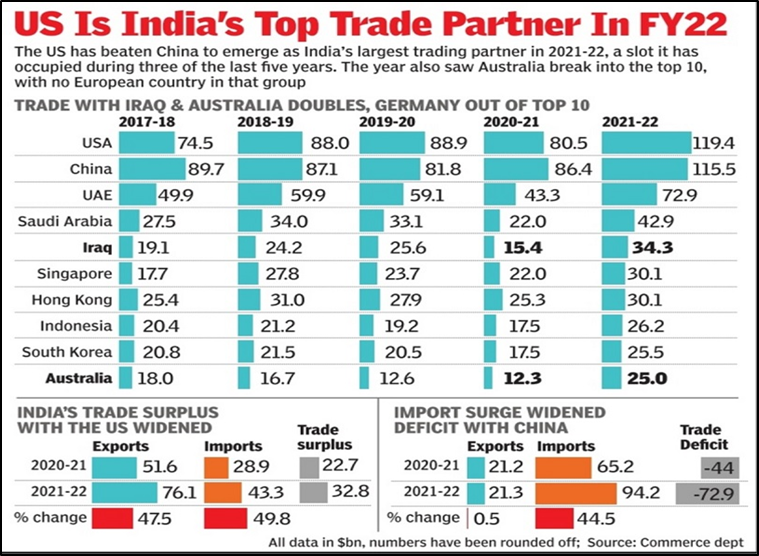In News:
- The US surpassed China to become India’s top trading partner in 2021-22, reflecting strengthening economic ties between the two countries.
What’s in Today’s Article:
News Summary
- India has now become America’s top trading partner as the bilateral trade between the US and India crossed US$ 119 billion.
Key Highlights

- Bilateral trade between India and US in 2021-22
- According to the data of the Commerce Ministry, in 2021-22, the bilateral trade between the US and India stood at $119.42 billion.
- It was $80.51 billion in 2020-21.
- Exports to the US increased to $76.11 billion in 2021-22 from $51.62 billion in previous fiscal year.
- Imports from US rose to $43.31 billion as compared to about $29 billion in 2020-21.
- America is one of the few countries with which India has a trade surplus.
- In 2021-22, India had a trade surplus of $32.8 billion with the US.
- Bilateral trade with China during the same period
- During 2021-22, India’s two-way commerce with China aggregated at $115.42 billion as compared to $86.4 billion in 2020-21.
- Exports to China marginally increased to $21.25 billion last fiscal year from $21.18 billion in 2020-21.
- On the other hand, imports from China jumped to $94.16 billion from about $65.21 billion in 2020-21.
- Trade gap rose to $72.91 billion in 2021-22 from $44 billion in previous fiscal year.
- Trade with other countries
- In 2021-22, the UAE with $72.9 billion, was the third largest trading partner of India.
- It was followed by Saudi Arabia ($42,85 billion), Iraq ($34.33 billion) and Singapore ($30 billion).
India-US Bilateral trade will continue to grow
- In the coming years, the bilateral trade between India and the US will continue to grow.
- This is due to the fact that New Delhi and Washington are engaged in further strengthening the economic ties as India is emerging as a trusted trading partner.
- India has joined a US-led initiative to set up an Indo-Pacific Economic Framework and this move would help boost economic ties further.
- Also, global firms are reducing their dependence only on China for their supplies and are diversifying business into other countries like India.
Concerns in Economic relations:
- Conflict between India’s Make in India and US' America First policy
- Solar equipments issue:
- US contends the domestic content requirement imposed by India in National Solar Mission is against WTO rules. India lost case in WTO.
- Issues related to Intellectual Property Rights (IPR) –
- Time and again, USTR Special 301 Report has classified India as Priority Watch List country.
- US contends that Section 3(d) (prevents ever-greening) and Section 84 (Compulsory Licensing) of Indian Patent Act, 1970 are not compliant with TRIPS of WTO.
- US frequently bans import of generic drugs from India on pretext of regulatory measures.
- India was placed in Currency Monitoring list of US
- India was for the first time, in April 2018, placed by the US in its currency monitoring list of countries with potentially questionable foreign exchange policies.
- In May 2019, US removed India from this list. However, in December 2020, it once again included India in its monitoring list.
- India’s removal from Generalized System of Preferences (GSP) list of US
- In May 2019, Trump administration terminated preferential trade terms to India which was extended under the U.S.’s GSP program.
- GSP program is a preferential tariff system extended by developed countries to developing countries.
- It is a preferential arrangement in the sense that it allows concessional low/zero tariff imports from developing countries
- In June 2019, India raised tariffs on 28 items exported from the US in retaliation to America’s withdrawal of preferential access for Indian products.
- H1B visa issue
- US is in the process of reforming the H1B visa programme.
- The H1-B visa is a non-immigrant visa given by the United States to employ skilled workers from other countries for various specialised fields of occupation for a certain period of time.
- Basically, it is an employment-based and non-immigrant visa category for temporary workers
- US feels that the programme has resulted into phenomenon like Outsourcing, Unemployment of US workers, and Wage depression.
- It has increased the visa fees which has affected the movement of Indian professionals. India is the largest user of H1B visas.










